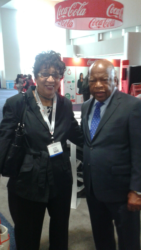
I attended 12 public schools in Chattanooga during times when almost everything was racially separated: schools, churches, restaurants, tours, organization memberships. After my high school graduation and an early marriage, I relocated with family to New England and eventually graduated from Southern Connecticut University. In the mid-seventies when I became an educator in a large suburban high school in Hamden, Connecticut, only about 10% of the school’s staff and student body was African American.
During my second year as a classroom teacher and academic educational diagnostician, myself and other African American staff began to discuss what we observed about the limits of inclusion. The lack of inclusive school activities and the absence of lessons on African American history and contributions to America were increasingly obvious. Our observations of the separation of races in the cafeteria at lunch, and during sports events in the gymnasium led us questioning, “What can we do?”
Most of the African American staff members in various roles and of different academic subjects, along with our White English department coordinator, met in my classroom. We planned a staff, student and community assembly program to celebrate African American History and Contributions Month. This initial planning committee invited a community organization’s leader, one of our own school’s principals, a student volunteer, a parent and one of the school system’s central office administrator to join us.
We realized the limitations and included musical composers, artist, i.e. Nat King Cole, Count Basis and other jazz performers in the music classes. The inclusion of African American literary projects, even the library books collection and their displays of African American history of various backgrounds and contributions, stood out.
The committee’s first African American History Month event was held after school in February with an open invitation to all students and their parents and community members. The program was in the gym, because the auditorium was being rehabilitated. It consisted of opening songs such as “We Shall Overcome,” and the national anthem. Famous African American poetry was recited by students from various backgrounds along with several dance selections. In addition, a local non-partisan clergyman shared a brief speech. It began to snow around noon. but we were excited to see that the snow didn’t prevent the attendance or participation of a number various ethnic groups.
The next year, the local Jewish Anti-Defamation League and a local state’s Afro American Historical Society organization joined our committee in the February program planning. We began to invite and collaborate with more staff members and with nearby school systems. Our planned projects were geared toward providing information about African American History, contributions and trail blazers for all school grades and in their communities. Shortly afterwards and in the following years, our school system’s superintendent and board of education mandated that all academic teachers include African America History lessons and on-going projects in their curricula. We were also happy to have a major Connecticut insurance company (Aetna) annually donate calendars featuring American Americans from different backgrounds and talents for every classroom and to share also with community organizations. Some other personal and private business provided displays on African American Month History as did the media.
Before transferring from my initial high school positions, the high school’s Student Council members requested that we name February, “Brotherhood and Sisterhood Month.” We did. It led to our schools and other town’s groups becoming more creative and expansive with their activities such as school assemblies, literary contest, research projects, and collaborations with each other. One of the parent groups, planned a “soul food” dinner night. I was personally inspired to do what I called “inclusions acts”and asked the only Asian American student from my homeroom to be the organist for my second wedding.
Today, about 25 years later, I realize that the increases of announcements, acknowledgements and planned activities for “African American ‘s History Month” in February and throughout the year should inspire and motivate more fairness, justice, inclusion and diversity.
During my summer school vacations and since my retirement, I have toured and volunteered in several foreign countries. I always enjoy observing international interactions and added multicultural awareness to my understanding of diversity.
On my return back to my hometown, Chattanooga, Tennessee, I continued to seek and develop relationships and participate with local organization with the same goals. Included in those relationships were my former class mates, some relatives, church members and new friends.
We are realizing our need for more racial equality and promoting inclusion and diversity, throughout the area. Media presentations and organization gatherings for African American’s history require more affirmative actions, inclusion, diversity, collaboration, representation, and promotion. Our public and private schools, Greek organizations, spiritual organizations should evaluate our needs for working together without reaching “conclusions” too soon, ” or just “closing the door” too early. And don’t overlook the need to reward all efforts and achievements, motivating the participants who are not “perfect” or make all A’s and or live in the ” inner-city” (…well, you know where I mean). More progress is the result of this inclusion, setting goals and to constantly evaluating, examining the outcomes, and moving us forward together.
Enjoy this February and the other months!
- African American History Month – by Eva Jo (Saddler) Johnson - February 9, 2023
- I’m Black and I’m Proud – by Eva Johnson - March 3, 2021
